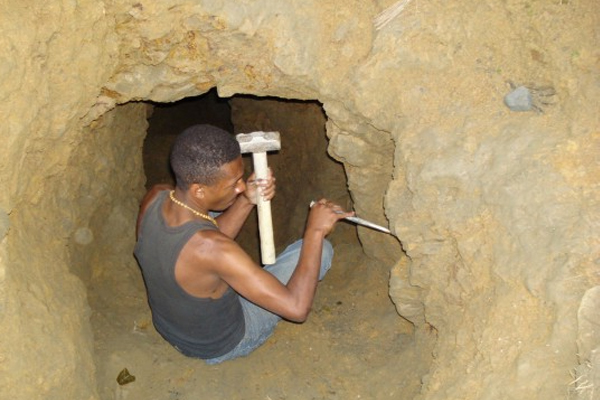Palladium Mining
PALLADIUM :
More than 80% of the palladium metal mining located at the Stillwater Mine is automated. Mechanized mining expenditures are approximately 40% less than those of non-mechanized conventional mining techniques. The majority of ore produced at the Stillwater Mine results from mechanized access ramp and fill mining. Other mechanized mining techniques used include sub-level stopping. In areas where the reef is constricted, Stillwater Mining employs a more discriminating yet less productive technique of slusher cut-and-fill mining to extract ore.
The ramp and fill technique initiates from a parallel stope or development stage, involving the utilization of handheld or mechanized drills for drilling and load-haul-dump (LHD) mucking equipment to transport the ore through an access ramp. Progress in the stope occurs in 9-foot increments, where the ground is securely reinforced with rock bolts and other materials as necessary. Once the stope is extracted, it is backfilled with waste rock and sand to create the base for the subsequent horizontal stope advancement uphill in 10-foot increments.
This particular mine utilizes a specialized approach known as slusher cut and fill mining to extract ore from narrow reef areas. In regions where the ore body tapers, typically less than 6 feet in width, conventional high-speed equipment faces challenges in accessing the reef for ore extraction without significant dilution. Dilution refers to the amount of waste rock left behind along with the ore during extraction.
A practical solution involves miners using a slusher, an electric device equipped with a 48-inch scraper bucket, to remove ore from a stope. The bucket is attached to a cable fixed to the face of the stope. Positioned at the rear of the ore chute, the mechanism pulls the bucket forward, collecting ore as it progresses.
HOW IS PALLADIUM OBTAINED?
Palladium typically belongs to the platinum group metals (PGMs). The primary sources of PGMs are the Bushveld igneous complex in South Africa and the Stillwater complex in Montana. Being a scarce element, palladium is often found alongside deposits of platinum, nickel, copper, silver, and gold, making it a by-product of mining these metals.
The discovery of palladium dates back to 1803 when English chemist William H. Wollaston identified it in London. Wollaston conducted experiments on the residues remaining from platinum dissolution in aqua regia, a potent mixture of hydrochloric and nitric acids. Through a series of chemical processes and subsequent heating of palladium cyanide, Wollaston successfully isolated the metal palladium.
MINING AND PROCESSING :
The extraction of palladium presents significant challenges due to its widespread distribution beneath the Earth's surface, necessitating the use of mechanical extraction techniques. These methods streamline the process and facilitate access to the deeper layers of the Earth's crust. As reserves in the upper layers become depleted, miners must delve deeper in search of more palladium.Palladium is predominantly found intermixed and bound with other metals like gold, platinum, copper, and zinc, requiring extraction followed by a separation process. Traditional refining methods are employed to group similar metals together. Commercially, palladium is primarily produced from copper-nickel deposits located in Canada and South Africa.
PRODUCTION OF PALLADIUM:
Since palladium occurs in a group of metals, it is produced from the residue left behind in the production of another metal, mostly nickel. The chemical differences of the metals are taken into consideration in the process of separating them.
Firstly, the residue is dissolved in aqua regia, which allows all the metals to form their nitrates. If silver is found to be present, then it is separated by forming silver chloride. When different kinds of elements are added to the mixture, all the elements eventually get separated. In this process, metals like rhodium sulfate, ruthenium, osmium, palladium, and others are extracted from the residue and compiled for commercial usage.
Extraction :
Palladium is otherwise extracted from platinum ores after platinum and gold have been removed. The metal is first converted to palladium chloride (PdCl2) and then purified to pure palladium.
Applications :
Palladium is used in various applications. Few of them are listed below:
Catalysis :
Palladium can be finely divided on carbon to produce a versatile catalyst. Playing the role of a catalyst, it can speed up hydrogenation and petroleum cracking. When dispersed on a conductive material, palladium can prove to be a very effective electrocatalyst for oxidizing primary alcohols. As a homogeneous catalyst, it can be used for highly selective chemical transformations.
Jewelry :
Being a precious metal, palladium has been useful in jewelry making since the 1930s as an alternative to platinum for making white gold, because of its natural white color. Since it is lighter than platinum and similar to gold, palladium can be made into a 100 nm thin form.
White gold is prepared as an alloy of gold with one of three metals: nickel, silver, and palladium. The palladium and gold alloy is more expensive compared to nickel and gold, but that can result in an allergic reaction rarely. Because of the consistent rise in the price of gold and platinum, palladium has been used as the principal metal in jewelry making in recent years.
Electronics :
The biggest application of palladium in electronics is in the production of capacitors where palladium is used as an electrode. It is also sometimes alloyed with nickel and used in connector plating in consumer electronics.
TOP PALLADIUM PRODUCING COUNTRIES :
USES OF PALLADIUM :
Palladium serves a dual purpose, primarily functioning as a catalyst and also being utilized in the creation of jewelry and specialized alloys.
In the chemical industry, it plays a crucial role in producing essential chemicals like sulfuric acid (H2SO4), pivotal in paper and fabric manufacturing.
Modern automobile catalytic converters frequently incorporate palladium catalysts.
The metal finds its way into various applications, including the crafting of watch springs, surgical tools, electrical contacts, dental fillings, and crowns.
Palladium facilitates the purification of hydrogen by enabling its passage through heated palladium.
Beyond industrial applications, it is employed in coin minting and the creation of astronomical mirrors.
In dentistry, palladium is essential for crafting caps, bridges, and crowns.
Its radioactive variant is utilized in cancer treatment.
Electronic devices benefit from palladium plating, while it also finds a place in photographic printing.
Additionally, palladium can effectively filter harmful substances from groundwater.
ANNUAL PALLADIUM USAGE :
PALLADIUM PRODUCTION IN THE WORLD :
The metal is mined as a by-product from other mineral deposits such as nickel-copper and polarite. Russia stands as the top producer of palladium, alongside countries like South Africa, Canada, and the United States. Australia also produces palladium as part of the PGMs group extraction on a small scale. Many sources reveal that one of the largest palladium mines in the United States is Stillwater mine in Montana, which accounts for a large portion of America's palladium and nickel-copper extraction. The five top palladium-producing countries are as follows:
Related Mining




















